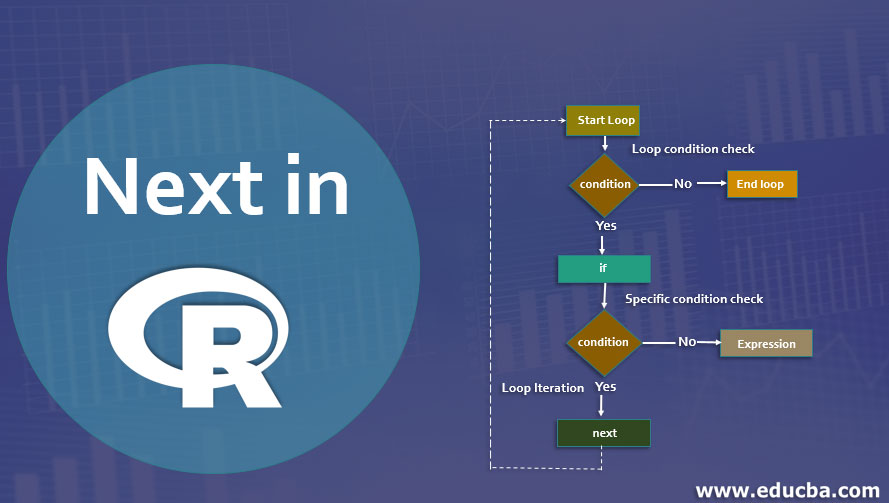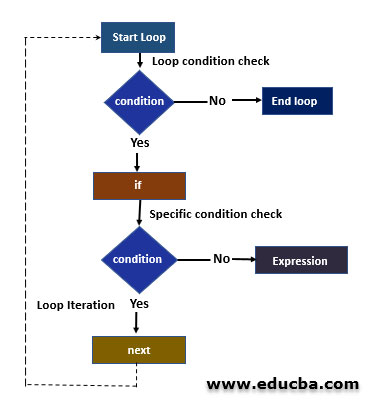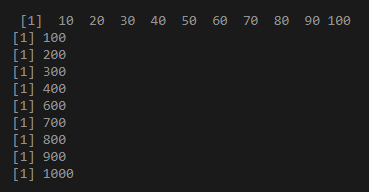Updated March 24, 2023

Introduction to Next in R
Next in R is an R statement, which is used with loop statements to provide additional control instructions to the loop processing logic in the runtime. It provisions the feature to skip any particular iteration of a statement or logical step while looping through the R statements. The next is a reserved keyword in the R language. The next statement in R language resembles with continue statement in other standard programming languages. The next statement is very much essential programming paradigm to implement the business rules to be ignored certain sensitive business data to be processed through a loop statement.
Syntax of Next in R
The next statement is always associated with the loop and if statements. The loop can be while loop or for loop or repeat loop. The following syntax represents the use of the next statement in R programming.
loop(condition){
if (condition) {
next
}
Expression statement
}
The syntax shows the next keyword is present inside if statement. The if block statement is present inside the loop statement. The next statement can also be used in the else block of the if-else scenario for more complex business logic implementations through R programming. The condition in the loop and if statement in the R code generally comprises of some variables and operators.
There can be multiple next statements based upon the multiple if statements and conditions evaluations. In certain business requirements scenario, one loop may contain another loop logic or known as a nested loop. The next statement can be used in the nested loop in the R language.
Flowchart of Next in R
- The flowchart for the next statement in R programming represents a generic loop scenario.
- It starts with a loop condition check followed by if statement and if condition check.
- The if statement block associated with the next statement. The next statement scopes the particular iteration and manages the control flow of the loop.
- The expression statement is associated with the loop scope.
- Next is applied to that particular if condition and it controls the innermost loop for nested loop scenario in case there are no other next statements implemented in the loop code.
- The flowchart associated with end loop flow.
How does Next Statement Work in R?
Let’s discuss how the next in R works:
- The next statement is used for flow control in the R language.
- The next is a reserved keyword which is used to halt the processing of the current loop iteration based upon the return value of the condition.
- The next statement advances the looping index in R programming.
- R runtime or the parser interprets the Loop code and checks the associated loop conditions.
- If the Loop condition returns a TRUE Boolean value then the flow control goes inside the loop block.
- If the Loop condition returns a FALSE Boolean value, it treats the loop condition not valid and immediately ends and exits from the loop.
- Once the control goes into the loop condition it checks the associated if conditions.
-
- In case the if statement condition returns a TRUE Boolean value, it moves goes into the if block scope.
- It then checks for the next statement.
- If it found the next statement in the if the scope, it halts the iteration without breaking the loop and propagates to the next iteration.
- If it found the IF condition returns a FALSE Boolean value,
- It will process for evaluating the expression statements for that loop iterations.
- It propagates to the loop condition check and next iteration once it completes the evaluation of the expression statements.
- In case the if statement condition returns a TRUE Boolean value, it moves goes into the if block scope.
-
- In the event of the FALSE Boolean return value from the loop condition, after the iteration has been completed, R parser treats it as completion of the loop logic and terminate the loop.
Example to implement Next in R
We will discuss the examples of this using R studio IDE and review the output in the R console.
Code:
# Assigning Vector variables #
SequenceNum <- c(10,20,30,40,50,60,70,80,90,100)
#Printing the Ventor Variables
print(SequenceNum)
#Generating sequence number by multiplying by 10, excluding sequence number 50
for (value in SequenceNum) {
if(value==50){
next
}
print(value*10)
}
Output:
Code Explanation:
- The R script in the above example shown uses a vector variable names ‘SequenceNum’ which stores the numbers from 10 to 100.
- The print function is used to print the stored values in the vector variable.
- The output shows the print statements printing the values of the vectors in the R console.
- The R script implements for loop to print the values of sequence number by multiplying number 10 on each vector values excluding sequence number 50.
- To implement the skip condition there is an if statement block added inside the for loop block.
- The next keyword is present inside the if statement block.
- The expression to compute the multiplication of value 10 with each of the vector value is represented in the print function.
- While the R script runs, its parser checks the for loop condition and iterate through for each vector values which is 10 iterations for this R code.
- The Parser checks the if condition weather the respective vector value is 50,
- As per the sequence number input data, it condition returns TRUE For the 5th iteration Boolean value and flow control propagate inside the If block.
- R parser found the next statement for this iteration.
- The next keyword halts this iteration and skips the evaluation for multiplication computation in the subsequent print function.
- R parser control moves back to for loop condition in the 6th iteration and continues the program.
- The Output prints the multiplication sequence numbers excluding computation value for sequence number 50.
Conclusion
The next statement is an integral component of R programming while developing code for loop logic. It helps to solve multiple condition check and process the loop iterations based upon the condition. It simplifies the R code by eliminating multiple if statements to implement the skip scenarios in the programming.
Recommended Articles
This is a guide to next in R. Here we discuss the syntax, flowchart, and working of next in R along with examples and code implementation. You can also go through our other suggested articles to learn more –


